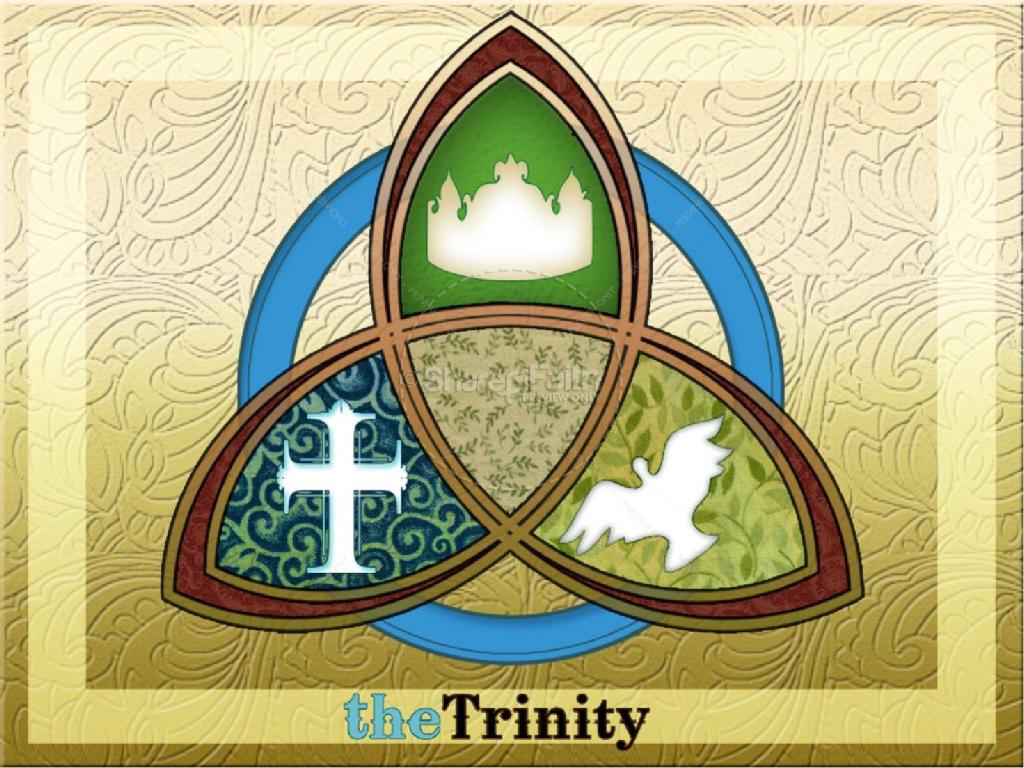Evidence of the Trinity in the Hebrew Scriptures

Table of Contents
I was recently in some discussions/debates online about the nature of God and whether the "Trinity" exists, or if God is purely singular and exists in different forms rather than different persons.
This idea that God has different "forms" or "modes" is what is known as Modalism (also sometimes called Sabellianism). This doctrine was condemned as heresy by Tertullian around 213 AD, and later by the bishop of Rome around 262 AD. A more modern sect of Christians, often called "Oneness Pentecostals", still hold to this heretical doctrine today.
Now, to be clear: I do believe in the Trinity and accept that it is the orthodox position to hold. But that doesn't mean I've always fully grasped the concept. This is something Christians have struggled to define for centuries, hence the sometimes confusing and lengthy language of the creeds (see here, here, here and here for example).
So after reading this debate online with some Oneness believers, I decided to look more into the Trinity to try and get my head around it as much as possible.
On my searching and reading, I came across an article by Arnold Fruchtenbaum on the Jews for Jesus website. He had taken the time to really look into the Tri-unity of God from a Jewish/Hebrew perspective to bring some clarity to the issue.
I found the article to be very helpful for my own understanding, and very illuminating to see the plurality of God in oneness hidden within the Hebrew language, something that is often lost in translation to our English bibles.
I'm no Hebrew scholar, so rather than try (and probably fail) to explain the language nuances to you, I sought permission to post a copy of the original article here. I hope that the information provided is as helpful to you as it was for me.
The original article begins below. Let me know your thoughts in the comments!
Jewishness and the Trinity
In a recent question-and-answer article, Rabbi Stanley Greenberg of Temple Sinai in Philadelphia wrote:
Christians are, of course, entitled to believe in a trinitarian conception of God, but their effort to base this conception on the Hebrew Bible must fly in the face of the overwhelming story of that Bible. Hebrew Scriptures are clear and unequivocal on the oneness of God . . . The Hebrew Bible affirms the one God with unmistakable clarity. Monotheism, an uncompromising belief in one God, is the hallmark of the Hebrew Bible, the unwavering affirmation of Judaism and the unshakable faith of the Jew.”
Whether Christians are accused of being polytheists or tritheists or whether it is admitted that the Christian concept of the Tri-unity is a form of monotheism, one element always appears: one cannot believe in the Trinity and be Jewish. Even if what Christians believe is monotheistic, it still does not seem to be monotheistic enough to qualify as true Jewishness. Rabbi Greenberg’s article tends to reflect that thinking.
He went on to say, “…under no circumstances can a concept of a plurality of the Godhead or a trinity of the Godhead ever be based upon the Hebrew Bible.” It is perhaps best then to begin with the very source of Jewish theology and the only means of testing it: the Hebrew Scriptures. Since so much relies on Hebrew language usage, then to the Hebrew we should turn.
1. God Is A Plurality
The Name Elohim
It is generally agreed that Elohim is a plural noun having the masculine plural ending “im.” The very word Elohim used of the true God in Genesis 1:1, “In the beginning God created the heavens and the earth,” is also used in Exodus 20:3, “You shall have no other gods (Elohim) before Me,” and in Deuteronomy 13:2, “…Iet us go after other gods (Elohim)…” While the use of the plural Elohim does not prove a Tri-unity, it certainly opens the door to a doctrine of plurality in the Godhead since it is the word that is used of the one true God as well as for the many false gods.
Plural Verbs used with Elohim
Virtually all Hebrew scholars do recognize that the word Elohim, as it stands by itself, is a plural noun. Nevertheless, they wish to deny that it allows for any plurality in the Godhead whatsoever. Their line of reasoning usually goes like this: When “Elohim” is used of the true God, it is followed by a singular verb; when it is used of false gods, it is followed by the plural verb. Rabbi Greenberg states it as follows:
“But, in fact, the verb used in the opening verse of Genesis is ‘bara’ which means ‘he created’—singular. One need not be too profound a student of Hebrew to understand that the opening verse of Genesis clearly speaks of a singular God.”
The point made, of course, is generally true because the Bible does teach that God is only one God and, therefore, the general pattern is to have the plural noun followed by the singular verb when it speaks of the one true God. However, there are places where the word is used of the true God and yet it is followed by a plural verb:
Genesis 20:13: “And it came to pass, when God (Elohim) caused me to wander [literally: They caused me to wander] from my father’s house…Genesis 35:7: “…because there God (Elohim) appeared unto him…” [Literally: They appeared unto him.]
2 Samuel 7:23: “…God (Elohim) went…” [Literally: They went.]
Psalm 58:12: “Surely He is God (Elohim) who judges…[Literally: They judge.]
The Name Eloah
If the plural form Elohim was the only form available for a reference to God, then conceivably the argument might be made that the writers of the Hebrew Scriptures had no other alternative but to use the word Elohim for both the one true God and the many false gods. However, the singular form for Elohim (Eloah) exists and is used in such passages as Deuteronomy 32:15-17 and Habakkuk 3:3. This singular form could have easily been used consistently. Yet it is only used 250 times, while the plural form is used 2,500 times. The far greater use of the plural form again turns the argument in favor of plurality in the Godhead rather than against it.
Plural Pronouns
Another case in point regarding Hebrew grammar is that often when God speaks of himself, he clearly uses the plural pronoun:
Genesis 1:26: Then God (Elohim) said,”Let Us make man in Our image, according to Our likeness.…”
He could hardly have made reference to angels since man was created in the image of God and not of angels. The Midrash Rabbah on Genesis recognizes the strength of this passage end comments as follows:
“Rabbi Samuel Bar Hanman in the name of Rabbi Jonathan said, that at the time when Moses wrote the Torah, writing a portion of it daily, when he came to this verse which says, “And Elohim said, let us make man in our image after our likeness,” Moses said, “Master of the universe, why do you give herewith an excuse to the sectarians (who believe in the Tri-unity of God).” God answered Moses, “You write and whoever wants to err, let him err.”1
It is obvious that the Midrash Rabbah is trying to simply get around the problem and fails to answer adequately why God refers to Himself in the plural.
The use of the plural pronoun can also be seen in:
Genesis 3:22: Then the LORD God (YHVH Elohim) said, “Behold, the man has become like one of Us…”Genesis 11:7: “Come, let Us go down, and there confuse their language…”
Isaiah 6:8: Also I heard the voice of the Lord, saying, “Whom shall I send, and who will go for Us?”
This last passage would appear contradictory with the singular “I” and the plural “us” except as viewed as a plurality (us) in a unity (I).
Plural Descriptions of God
One point that also comes out of Hebrew is the fact that often nouns and adjectives used in speaking of God are plural. Some examples are as follows:
Ecclesiastes 12:1: “Remember now you creator…” [Literally: creators.]
Psalm 149:2: “Let Israel rejoice in their Maker.” [Literally: makers.]
Joshua 24:19: “…holy God…” [Literally: holy Gods.]
Isaiah 54:5: “For your Maker is your husband…” [Literally: makers, husbands.]
Everything we have said so far rests firmly on the Hebrew language of the Scriptures. If we are to base our theology on the Scriptures alone, we have to say that on the one hand they affirm God’s unity, while at the same time they tend towards the concept of a compound unity allowing for a plurality in the Godhead.
The Shema
Deuteronomy 6:4: Hear, O Israel: The LORD our God, the LORD is one!
Deuteronomy 6:4, known as the Shema, has always been Israel’s great confession. It is this verse more than any other that is used to affirm the fact that God is one and is often used to contradict the concept of plurality in the Godhead. But is it a valid use of this verse?
On one hand, it should be noted that the very words “our God” are in the plural in the Hebrew text and literally mean “our Gods.” However, the main argument lies in the word “one,” which is a Hebrew word, echad. A glance through the Hebrew text where the word is used elsewhere can quickly show that the word echad does not mean an absolute “one” but a compound “one.” For instance, in Genesis 1:5, the combination of evening and morning comprise one (echad) day. In Genesis 2:24, a man and a woman come together in marriage and the two “shall become one (echad) flesh.” In Ezra 2:64, we are told that the whole assembly was as one (echad), though of course, it was composed of numerous people. Ezekiel 37:17 provides a rather striking example where two sticks are combined to become one (echad). The use of the word echad in Scripture shows it to be a compound and not an absolute unity.
There is a Hebrew word that does mean an absolute unity and that is yachid, which is found in many Scripture passages,2 the emphasis being on the meaning of “only.” If Moses intended to teach God’s absolute oneness as over against a compound unity, this would have been a far more appropriate word. In fact, Maimonides noted the strength of “yachid” and chose to use that word in his “Thirteen Articles of Faith” in place of echad. However, Deuteronomy 6:4 (the Shema) does not use “yachid” in reference to God.
II. God Is At Least Two
Elohim and YHVH Applied to Two Personalities
As if to even make the case for plurality stronger, there are situations in the Hebrew Scriptures where the term Elohim is applied to two personalities in the same verse. One example is Psalm 45:7-8:
“Your throne, O God, is forever and ever;
A scepter of righteousness is the scepter of Your kingdom.
You love righteousness and hate wickedness;
Therefore God, Your God, has anointed You
With the oil of gladness more than Your companions.”
It should be noted that the first Elohim is being addressed and the second Elohim is the God of the first Elohim. And so God’s God has anointed Him with the oil of gladness.
A second example is Hosea 1:7:
“Yet I will have mercy on the house of Judah, will save them by the LORD their God, and will not save them by bow, nor by sword or battle, by horses or horsemen.”
The speaker is Elohim who says He will have mercy on the house of Judah and will save them by the instrumentality of YHVH, their Elohim. So Elohim number one will save Israel by means of Elohim number two.
Not only is Elohim applied to two personalities in the same verse, but so is the very name of God. One example is Genesis 19:24which reads:
“Then the LORD rained brimstone and fire on Sodom and Gomorrah, from the LORD out of the heavens.”
Clearly we have YHVH number one raining fire and brimstone from a second YHVH who is in heaven, the first one being on earth.
A second example is Zechariah 2:8-9:
For thus says the LORD of Hosts: “He sent Me after glory, to the nations which plunder you; for he that touches you touches the apple of His eye. For surely I will shake My hand against them, and they shall become spoil for their servants. Then you will know that the LORD of hosts has sent Me.”
Again, we have one YHVH sending another YHVH to perform a specific task.
The author of the Zohar sensed plurality in the Tetragrammaton3 and wrote:
“Come and see the mystery of the word YHVH: there are three steps, each existing by itself: nevertheless they are One, and so united that one cannot be separated from the other. The Ancient Holy One is revealed with three heads, which are united into one, and that head is three exalted. The Ancient One is described as being three: because the other lights emanating from him are included in the three. But how can three names be one? Are they really one because we call them one? How three can be one can only be known through the revelation of the Holy Spirit.”4
III. God Is Three
How Many Persons Are There?
If the Hebrew Scriptures truly do point to plurality, the question arises, how many personalities in the Godhead exist? We have already seen the names of God applied to at least two different personalities. Going through the Hebrew Scriptures, we find that, in fact, three and only three distinct personalities are ever considered divine.
1. First, there are the numerous times when there is a reference to the Lord YHVH. This usage is so frequent that there is no need to devote space to it.
2. A second personality is referred to as the Angel of YHVH. This individual is always considered distinct from all other angels and is unique. In almost every passage where He is found He is referred to as both the Angel of YHVH and YHVH Himself. For instance, in Genesis 16:7 He is referred to as the Angel of YHVH, but then in 16:13 as YHVH Himself. In Genesis 22:11 He is the Angel of YHVH, but God Himself in 22:12. Other examples could be given.5 A very interesting passage is Exodus 23:20-23 where this angel has the power to pardon sin because God’s own name YHVH is in him, and, therefore, he is to be obeyed without question. This can hardly be said of any ordinary angel. But the very fact that God’s own name is in this angel shows His divine status.
3. A third major personality that comes through is the Spirit of God, often referred to as simply the Ruach Ha-kodesh. There are a good number of references to the Spirit of God among which are Genesis 1:2, 6:3; Job 33:4; Psalm 51:11; Psalm 139:7; Isaiah 11:2, etc. The Holy Spirit cannot be a mere emanation because He contains all the characteristics of personality (intellect, emotion and will) and is considered divine.
So then, from various sections of the Hebrew Scriptures there is a clear showing that three personalities are referred to as divine and as being God: the Lord YHVH, the Angel of YHVH and the Spirit of God.
The Three Personalities in the Same Passage
Nor have the Hebrew Scriptures neglected to put all three personalities of the Godhead together in one passage. Two examples are Isaiah 48:12-16 and 63:7-14.
Because of the significance of the first passage, it will be quoted:
“Listen to Me, O Jacob, and Israel, My called: I am He, I am the First, I am also the Last. Indeed My hand also has laid the foundation of the earth, and My right hand has stretched out the heavens; when I call to them, they stand up together. All of you, assemble yourselves, and hear! Who among them has declared these things? The LORD has loved him; he shall do His pleasure on Babylon, and His arm shall be against the Chaldeans. I, even I, have spoken; yes, I have called him, I have brought him, and his way will prosper. Come near to Me, hear this: I have not spoken in secret from the beginning; from the time that it was, I was there. And now the Lord GOD and His Spirit have sent me.”
It should be noted that the speaker refers to himself as the one who is responsible for the creation of the heavens and the earth. It is clear that he cannot be speaking of anyone other than God. But then in verse 16, the speaker refers to himself using the pronouns of I and me and then distinguishes himself from two other personalities. He distinguishes himself from the Lord YHVH and then from the Spirit of God. Here is the Tri-unity as clearly defined as the Hebrew Scriptures make it.
In the second passage, there is a reflection back to the time of the Exodus where all three personalities were present and active. The Lord YHVH is referred to in verse 7, the Angel of YHVH in verse 9 and the Spirit of God in verses 10, 11 and 14. While often throughout the Hebrew Scriptures God refers to Himself as being the one solely responsible for Israel’s redemption from Egypt, in this passage three personalities are given credit for it. Yet, no contradiction is seen since all three comprise the unity of the one Godhead.
Conclusion
The teaching of the Hebrew Scriptures, then, is that there is a plurality of the Godhead. The first person is consistently called YHVH while the second person is given the names of YHVH, the Angel of YHVH and the Servant of YHVH. Consistently and without fail, the second person is sent by the first person. The third person is referred to as the Spirit of YHVH or the Spirit of God or the Holy Spirit. He, too, is sent by the first person but is continually related to the ministry of the second person.
If the concept of the Tri-unity in the Godhead is not Jewish according to modern rabbis, then neither are the Hebrew Scriptures. Jewish Christians cannot be accused of having slipped into paganism when they hold to the fact that Jesus is the divine Son of God. He is the same one of whom Moses wrote when he said:
“Behold, I send an Angel before you, to keep you in the way, and to bring you into the place which I have prepared. Beware of Him and obey His voice; do not provoke Him, for He will not pardon your transgressions; for My name is in Him. But if you indeed obey His voice and do all that I speak, then I will be an enemy to your enemies and an adversary to your adversaries. For My Angel will go before you and bring you in to the Amorites and the Hittites and the Perizzites and the Canaanites and the Hivites and the Jebusites; and I will cut them off.”
—Exodus 23:20-23
New Testament Light
In keeping with the teachings of the Hebrew Scriptures, the New Testament clearly recognizes that there are three persons in the Godhead, although it becomes quite a bit more specific. The first person is called the Father while the second person is called the Son. The New Testament answers the question of Proverbs 30:4: “…What is His name, and what is his Son’s name, if you know?” His son’s name is Yeshua (Jesus). In accordance with the Hebrew Scriptures, he is sent by God to be the Messiah, but this time as a man instead of as an angel. Furthermore, He is sent for a specific purpose: to die for our sins. In essence, what happened is that God became a man (not that man became God) in order to accomplish the work of atonement.
The New Testament calls the third person of the Godhead the Holy Spirit. Throughout the New Testament he is related to the work of the second person, in keeping with the teaching of the Hebrew Scriptures. We see, then, that there is a continuous body of teaching in both the Old and New Testaments relating to the Tri-unity of God.
Footnotes
- Midrash Rabbah on Genesis 1:26, New York: NOP Press, N.D.
- Genesis 22:2,12; Judges 11:34; Psalm 22:21; 25:16; Proverbs 4:3; Jeremiah 6:26; Amos 8:10; Zechariah 12:10
- ″Personal Name of God of Israel,” written in Hebrew Bible with the four consonants YHWH. Pronunciation of name has been avoided since at least 3rd c. B.C.E.; initial substitute was “Adonai” (“the Lord”), itself later replaced by “ha-Shem” (“the Name”). The name Jehovah is a hybrid misreading of the original Hebrew letters with the vowels of “Adonai.”—Encyclopedic Dictionary of Judaica, p. 593
- Zohar, vol. III, 288, vol. II, 43, Hebrew editions. See also Soncino Press edition, vol. III, 134.
- In Genesis 31 he is the Angel of God in verse 11, but then he is the God of Bethel in verse 13. In Exodus 3 he is the Angel of YHVH in verse 2 and he is both YHVH and God in verse 4. In Judges 6 he is the Angel of YHVH in verses 11, 12, 20, and 21 but is YHVH himself in verses 14, 16, 22 and 23. Then in Judges 13:3 and 21 he is the Angel of YHVH but is referred to as God himself in verse 22.
Leave a comment Like Back to Top Seen 11.2K times Liked 3 times
Enjoying this? Consider contributing regular gifts for this content on Patreon.
* Patreon is a way to join your favorite creator's community and pay them for making the stuff you love. You can simply pay a few pounds per month or per post that a creator makes, and in return receive some perks!
Subscribe to Updates
If you enjoyed this, why not subscribe to free email updates and join over 831 subscribers today!
My new book is out now! Order today wherever you get books
Recent Posts
Luke J. Wilson | 2 days ago | History
We often hear that Jesus was “about 33 years old” when he was crucified and only had a three-year ministry. But have you ever wondered how precise that number is, or why we assume that was his age, especially when Scripture doesn’t specify? Table of Contents The Gospel of Luke: “About Thirty” Early Church Testimony: Irenaeus and the Longer Ministry Historical Anchors: Birth, Pilate, and the Crucifixion Window The Death of Herod Cross-referencing with Pilate, Caiaphas, and Jesus When Did Tiberius Begin to Reign? 1. From his co-regency with Augustus (AD 11–12) 2. From the death of Augustus (AD 14) How Does This Affect Jesus’ Age and Ministry Start? Astronomy and the Timing of Passover Estimated Lengths of Jesus’ Ministry Why This Matters In Summary Further Reading I’ve long wondered about this, especially when the Pharisees accused Jesus of not being close to fifty, which seems odd if he was only in his early 30s. Then I later discovered Irenaeus also had similar thoughts in the second century, and the plot thickened! I’ve had this rumbling around in the back of my mind for a few years now and slowly chewed it over. So now I’m going to try and present the evidence, rather than rely solely on tradition and assumptions, and piece together what the Gospels, early Church Fathers, historical data, and even astronomy can tell us about the potential age of Jesus and the length of his ministry. What follows is a deeper, richer look at the life and death of Jesus and what we can learn by following the evidence. The Gospel of Luke: “About Thirty” Luke 3:23 tells us plainly: Jesus was about thirty years old when he began his work. This statement has historically been the anchor point for dating Jesus’ ministry. Most take this to mean he was around 30 at his baptism, which marked the beginning of his public ministry. Something to bear in mind here is that Luke isn’t exact and only says “about thirty”, so he could have been slightly younger or older at the time. But being around the age of 30 would align with the requirements of priests, which Jesus was also fulfilling the role of (Hebrews 2:17; Numbers 4:1–4; Numbers 8:23–25). But from there, it’s traditionally assumed that Jesus ministered for just three years before his death, mainly based on the Gospel of John, which mentions three Passovers (John 2:13, 6:4, 11:55). However, John also says at the end of his Gospel in John 21:25: But there are also many other things that Jesus did; if every one of them were written down, I suppose that the world itself could not contain the books that would be written. This is a clear reminder, even if John is being hyperbolic here: not everything was recorded. Considering that the Synoptic Gospels only mention one Passover, the number of Passovers we read about in John may not reflect the total number Jesus experienced during his ministry. They may also serve a theological point (three being a prominent number in Scripture) rather than a chronological one. Early Church Testimony: Irenaeus and the Longer Ministry In the second century, Irenaeus, bishop of Lyon and disciple of Polycarp (who had also known the Apostle John and was likely his disciple), made an interesting claim about the age of Jesus — and backed it up by saying it was verified by the Apostle John himself! In Against Heresies (2.22.4–6), Irenaeus wrote: …our Lord possessed [old age] while He still fulfilled the office of a Teacher, even as the Gospel and all the elders testify, those who were conversant in Asia with John, the disciple of the Lord, [affirming] that John conveyed to them that information. … Some of them, moreover, saw not only John but the other apostles also, and heard the same account from them, and bear testimony to this statement. He argued that the line in John 8:57: Then the Jews said to him, ‘You are not yet fifty years old, and have you seen Abraha...
KingsServant | 12th March 2025 | Islam
This is a guest post by “KingsServant” In 2019 a book called Defying Jihad was published by Tyndale House, the reputable Christian publisher telling the story of “Esther Ahmad” a pseudonym used by the author alongside her co-author Craig Borlase, who has previously written alongside, well known Christian personalities such as Matt Redman the singer and Andrew Brunson, an American pastor imprisoned by the Turkish government. As I began to read this book over this past year I was expecting an encouraging account of how a former Jihadi found Christ and escaped her previous accomplices. Very quickly, however, I became uncomfortable, her descriptions of her background involved allegedly committed Muslims doing very un-Islamic things and the unnamed militant group doing unusual things that didn’t fit my knowledge gained from years of study of Islam and interactions with Muslims, including extremists. As my doubts about the authenticity of the book solidified, and yet I couldn’t find anyone else who had questioned these things before me, or on the other hand provided verification of her story. I decided to contact Craig. During our brief and cordial email exchange he told me that he had been in touch with people who knew Esther after she escaped her family home, but so far has not suggested he has any other lines of evidence confirming any of the key elements of her account before that time. As a result, I am writing this article to draw attention to the aspects that raise suspicion. According to “Esther’s” story, she was raised in Pakistan where she was sent to an extremist madrassa (or Muslim school) for girls, there they were shown images of victims of violence and told that Christians and Jews were responsible - the emphasis on Jews and particularly Christians by a militant group based in Pakistan is strange. All the terrorist groups in Pakistan direct their efforts towards Hindus (especially in Kashmir) or other Muslims, since Christians are such a tiny minority there. Things rapidly become even stranger when a Mullah displays weapons to the group of girls telling them “… one day you will get to handle these” as the book continues describing them being encouraged to aspire to physical violence towards Jews and Christians specifically, the description of “Aunt Selma” volunteering for and dying fighting Jihad is likewise out of place. Islamic terrorist groups very rarely recruit women for combat roles, as Devorah Margolin describes Hamas and ISIS as departing from convention by encouraging female participation in violence and even then in only a very restricted way under particular circumstances with a specific fatwa (or Islamic ruling) being issued.1 On page 33, the militant group leader “Anwar” suggests that Esther could find a husband in the west to bring him to Islam. It is strictly forbidden for a Muslim woman to marry a non Muslim man, the idea that they would be encouraged by a scholar to date is about as unbelievable. In a conservative Pakistani culture, she would more likely find herself the victim of a so-called “honour killing” for such a thing.2 After her initial chance encounters with her future husband “John” (not as a result of trying to follow “Anwar’s” advice), on page 92 it is recorded that he said to her “… I’m not against your faith and beliefs…”, it’s the kind of thing that we might expect a liberal in the west to say, but not a Pakistani believer who knows that Islam denies that Jesus is the Son of God and that he died for sinners. Following her conversion according to her account, she engaged in a number of public debates with clerics in which she defended her decision to leave Islam and follow Christ. It is not uncommon for apostates to have meetings with scholars arranged by their family members in the hope that they might be won back to Islam, but it is very surprising that her influential father would want to give his apostate daughter su...
Luke J. Wilson | 05th March 2025 | Lent
Ash Wednesday marks the beginning of Lent, a season of repentance, fasting, and preparation for Easter in the Christian calendar. It is observed by many Western Christian traditions, including the Roman Catholic Church, Anglican Communion, Lutheran churches, and some Methodist and Reformed communities. The day falls 46 days before Easter Sunday and is always on a Wednesday. Origins and Historical Development The practice of Ash Wednesday can be traced back to the early centuries of Christianity, though its formal observance developed over time. The use of ashes as a sign of repentance has deep biblical roots, appearing frequently in the Old Testament. People would cover themselves with ashes as an outward sign of sorrow for sin and a desire to turn back to God (e.g., Job 42:6, Daniel 9:3, Jonah 3:6). By the 8th century, the imposition of ashes on the forehead became a common practice in the Western Church. Pope Urban II (r. 1088–1099) helped formalise Ash Wednesday as the official beginning of Lent, reinforcing the idea of a season of penitence leading up to Easter. The name “Ash Wednesday” itself comes from the tradition of marking the faithful with ashes, typically in the shape of a cross, while the priest or minister recites words such as, “Remember that you are dust, and to dust you shall return” (Genesis 3:19) or “Repent, and believe in the Gospel” (Mark 1:15). The Lenten Fast Fasting has always been a central aspect of Lent, and by the time of the Council of Nicaea (AD 325), a forty-day period of fasting before Easter had become a standard part of Church practice. This was based on the example of Jesus’ forty days in the wilderness (Matthew 4:1–2) and was intended to prepare believers spiritually for the Passion and Resurrection of Christ. Athanasius, the great bishop of Alexandria, regularly wrote paschal (Easter) letters to the churches to encourage fasting, self-control, and moderation during this period. His writings provide valuable insight into how Lent was observed in the early Church and confirm that the practice was well established long before later claims that it had pagan origins. In one of his letters, written around AD 332, he describes the structure of the Lenten fast: The beginning of the fast of forty days is on the fifth of the month Phamenoth [Ash Wednesday]; and when, as I have said, we have first been purified and prepared by those days, we begin the holy week of the great Easter on the tenth of the month Pharmuthi [Palm Sunday], in which, my beloved brethren, we should use more prolonged prayers, and fastings… — Athanasius, Letter III (c. AD 332) The early Lenten fast was stricter than modern observances. Many early Christians abstained not only from meat but also from dairy, eggs, and wine. In some traditions, believers ate only one meal per day, typically in the evening. While practices have evolved over time, the principle remains the same: Lent is a time of self-discipline, spiritual renewal, and preparation for Easter. Meaning and Observance of Ash Wednesday Ash Wednesday serves as a solemn reminder of human mortality and the need for repentance. The ashes, often made by burning the palm branches from the previous year’s Palm Sunday, symbolise both death and the hope of renewal in Christ. The day is also marked by fasting and abstinence in many traditions, such as within Roman Catholicism and Eastern Orthodoxy, the faithful are required to fast and to abstain from meat and dairy on various days. Many other denominations encourage similar practices or personal acts of self-denial as a way of focusing on spiritual growth. Churches hold special services where worshippers receive the imposition of ashes. The act is not merely ritualistic but is meant to be a public declaration of one’s commitment to turn away from sin and seek God’s grace. Greek Orthodox Yearly Fasting Calendar (2025). Fasting isn’t just for Lent! An Anglican Perspective The Ch...
Luke J. Wilson | 28th February 2025 | Early Church
The Bible is often described as “God-breathed,” a phrase taken from 2 Timothy 3:16: “All scripture is inspired by God and is useful for teaching, for reproof, for correction, and for training in righteousness.” But what does it mean for Scripture to be “inspired,” and how did the books of the Bible come to be recognised as part of the canon — the authoritative collection of writings that make up the Bible? Were they really “decided” at the Council of Nicaea, as some popular myths claim? Table of Contents Understanding Biblical Inspiration What is the Canon? The Septuagint and the Deuterocanonical Books How Were the Books of the Bible Selected? Why Were Some Books Excluded? Has the Bible Been Edited or Corrupted Over Time? Did the Church Decide the Canon at Nicaea? Conclusion Further Reading Understanding Biblical Inspiration A helpful analogy for inspiration is that of an architect designing a great building. Consider St. Paul’s Cathedral in London — Christopher Wren was the architect who planned and designed it, yet he himself did not lay a single brick. Instead, countless workers followed his design to bring the cathedral into existence. Similarly, God is the ultimate author of Scripture, yet He worked through human writers to bring His message to us. The Holy Spirit inspired them, guiding their words while allowing their personalities, historical context, and literary style to remain evident in their writings. This means that while the Bible is written by human hands, it carries divine authority because its true source is God Himself. The process of inspiration does not mean God dictated each word like a secretary taking notes, or by possessing the authors, but rather that He ensured the truth of His message was faithfully recorded by the biblical writers. What is the Canon? The word “canon” comes from the Greek κανών (kanōn), meaning “rule” or “measuring rod.” In the context of the Bible, the canon refers to the official list of books recognised as divinely inspired and authoritative for faith and practice. The canon developed over time as the early church recognised which writings carried divine authority. The Old Testament canon was largely settled by the time of Jesus, based on the Hebrew Scriptures used in the Jewish community. The New Testament canon, however, was formed through a process of discernment over several centuries, as the church recognised which writings were truly inspired and authoritative. The Septuagint and the Deuterocanonical Books The Septuagint (LXX) is the Greek translation of the Hebrew Scriptures, produced in the 3rd-2nd centuries BC. It was widely used by Greek-speaking Jews and later by early Christians, including the apostles. The Septuagint included several books not found in the Hebrew Bible, known as the Deuterocanonical books (such as Tobit, Judith, Wisdom, and 1–2 Maccabees). While these books were accepted in many early Christian communities and remain part of the canon in Catholic and Orthodox traditions, Protestant reformers later removed them, considering them useful but not divinely inspired at the same level as the rest of Scripture. The reformers’ view was influenced by Jerome, who, in the 4th century, argued that these books were not part of the Hebrew Bible and therefore should be considered separate. However, he still included them in his Latin Vulgate translation, recognising their historical and devotional value. The Reformers followed Jerome’s stance, moving these books into a separate section rather than outright removing them. It was not until the 19th century that an American Bible Society, citing printing costs and other practical considerations, physically removed these books entirely from Protestant Bibles. This decision solidified what is now commonly referred to as the “Protestant canon” of 66 books. And the other Books (as Hierome saith) the Church doth read for example o...













